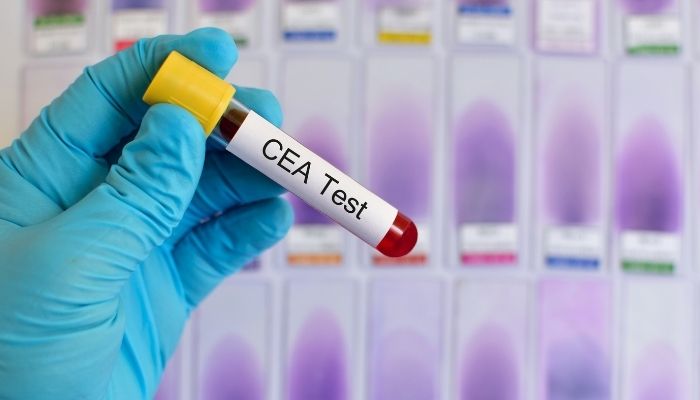The CEA blood test is defined as the carcinoembryonic antigen test. It is a specific kind of protein which is contained in a growing baby’s tissues. CEA levels usually come down or vanish completely after taking birth. Healthy individuals should ideally have no/zero CEA levels in their bodies.
| Name of the Test | CEA Blood Test |
| Full Form | Carcinoembryonic Antigen Test |
| What does it measure? | The amounts of CEA contained in body fluids and blood |
| What does a high level indicate? | It may indicate specific cancer types (rectum, colon, ovary, prostate, thyroid, lung, liver, etc.) or conditions like emphysema, non-cancerous breast diseases, and cirrhosis |
Knowing More About the CEA Blood Test
CEA itself falls in the tumor marker segment, i.e., those elements created by regular cells in response to any bodily cancer or cancer cells themselves. The CEA test normal range is desirable when taking a CEA lab test, since higher levels may indicate cancer in the rectum, colon, ovary, lungs, liver, prostate or even thyroid. In fact, these higher levels may also be an indication of other ailments like emphysema, cirrhosis and even breast disease which is non-cancerous.
While the test cannot indicate the specific type of cancer or the presence of cancer cells, it will help in tracking how well your treatment is going and whether it has spread to other body parts. The test is sometimes known as CEA assay as well.
Top 6 Uses of CEA Blood Test
The test helps with the following:- Tracking treatment for those suffering from specific cancer types.
- Understanding the cancer stage, checking the spread of cancer and the size of the tumor.
- Evaluate whether cancer has come back after getting treatment.
Top 5 Purpose of CEA Blood Test
Those diagnosed with cancer will require this test prior to beginning treatment and periodically throughout the treatment cycle as well. It will help doctors view the progress of treatments. CEA tests may be done after the conclusion of treatment or at a later stage to see whether there is any recurrence of cancer.Procedure of CEA Blood Test
CEA counts in the blood are measured through this test. Blood samples are taken from the veins with a small needle being inserted into the arm. A small volume of blood is taken into the vial/tube. The procedure only takes a few minutes. CEA tests sometimes take place for abdominal or spinal fluid where samples are taken with a syringe/needle.These are the fluids that could be tested in this case:
- Peritoneal fluid- This is present in the abdominal wall lining.
- Cerebrospinal fluid or CSF- It is a colorless and clear liquid contained in the spinal cord.
- Pleural fluid- This is present in the chest cavity, covering the exterior of every lung.
Risk Elements of CEA Blood Test
There are negligible risks to the blood test. You may experience a little bruising or pain at the place where the needle is inserted although it may go away after some time. Body fluid tests are completely safe although a few rare side effects include the following:- CSF tests may rarely lead to tenderness or pain in the back where the needle was put in. Some people also report headaches after taking the test.
- Peritoneal fluid tests may lead to lightheadedness, dizziness and other symptoms with some risks of bladder/bowel damages which may otherwise lead to infections.
- Pleural fluid tests may lead to enhanced risks of infections, damages to the lungs or loss of blood.
Decoding the Results of CEA Blood Test
If you were already tested prior to beginning treatment, then the results may indicate the following:- Low CEA levels, indicating a small tumor, without the cancer having spread to other body parts.
- High CEA levels, indicating a bigger tumor and spread of cancer throughout the body.
- CEA levels were high and remained so even after treatment, indicating lack of body responses to the latter.
- CEA levels were high but came down thereafter, indicating progress of the treatment.
- CEA levels came down but increased once again, indicating recurrence in cancer even after treatment.


